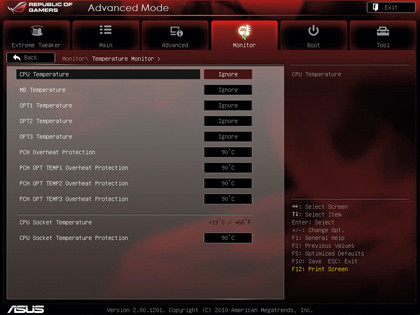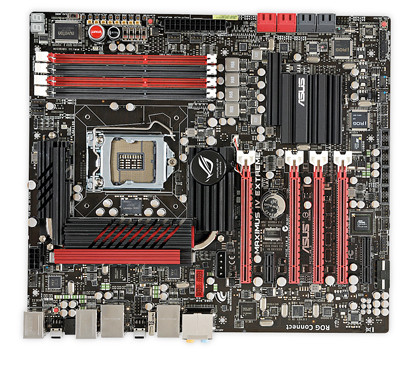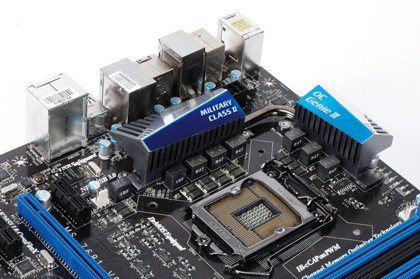New motherboard tech: key advances explained
Overclocking, reduced power consumption and more
The new Unified Extensible Firmware Interface (UEFI) looks like it is finally going to become mainstream on PCs (it has been around on Macs and servers for yonks). If you get one of the new Intel P67 boards for Sandy Bridge then you'll encounter it.

UEFI: UEFI BIOS pretties up the blue screen we have all come to loathe
UEFI looks very different to the blue screen BIOS we've come to know, you can use a mouse for a start and it has colourful screens.
UEFI is largely written in C rather than Assembler (although at the core there is a little to get things going) and is a completely different proposition to the traditional BIOS, which is expecting to see a 16-bit processor with 1MB of memory and dates from the IBM AT.
Technically the big gain is the new Globally Unique IDentifier Partition Table or GPT for short. This enables you to boot from drives over 2.19GB, about time because drives long since passed that landmark. This is the one big immediate practical benefit.
UEFI can be easily extended: it is in effect a miniature OS of its own that isn't tied to any specific hardware. It can have hardware drivers, utilities, diagnostic tools and all sorts added in.
You could, for example, run a system back-up utility from within UEFI and also access a network. It can load code from attached hardware, so your graphics card could add a screen into the BIOS for direct control, for example.
Get daily insight, inspiration and deals in your inbox
Sign up for breaking news, reviews, opinion, top tech deals, and more.
The UEFI is one area where the board guys can, at relatively little expense, add value by enabling easy access to all the features, set-up profiles and so forth. It can go a little too far though, the first version we saw from MSI included the game Breakout on it, bizarre. Still MSI promises that it'll be continuing to "spice up the BIOS".
Enter the P67
Given that motherboard features are so directly linked to the main chipset, the release of a new set of silicon from Intel is a big deal, and means a whole new set of boards all round.

P67 HEAVEN: The current top P67 motherboard, Asus Maximus IV Extreme
Intel's latest is the H67/P67, is a sixth generation chipset designed for the Sandy Bridge processor. The H67 is the budget version, or 'affordable' as the marketing people have it, while the P67 is more fully-featured offering.
The good news includes two SATA 6Gbps ports to accompany the four SATA 3Gbps ports. Plus, for the P67 at least, two PCI-E x8 slots. You'll also get UEFI, of primary importance if you want to run nice big hard drives as boot devices. Still no USB 3.0 though, although you do get up to 14 USB 2.0 ports, which should just about be enough we think. It's up to the manufacturers then to add the extra silicon for USB 3.0.
Intel has decided to severely limit overclocking on Sandy Bridge, with just about everything locked to the base clock including USB, SATA, DMI and PCI-E. This base clock is generated by the P67 chipset, so you don't get an external clock the board guys can program directly. Plus, since everything is locked together, turning it up can cause unexpected consequences, apparently even a modest increase can cause the USB or SATA to fail. Ouch.
There will be a K-Series version that will have an unlocked CPU multiplier, but for most versions it will be locked down.
Early results with the K-series have at least been promising, 5GHz has been widely reported. This lockdown is bad news for the board guys, overclocking is where they can score points with you and off each other. So obviously it has to be done, and it will. No motherboard manufacturer can afford to be left behind in the overclocking arms race.
Getting an unlocked multiplier on all versions looks like the best option, leaving the base clock alone and avoiding complicated asynchronous systems which may or may not work. We shall see, as Intel has claimed to lock chips before, only to earn our gratitude by not implementing it (as with Lynnfield).
Intel appears to swing backwards and forwards on overclocking, one minute it releases chips you can easily pump-up, and the next it tries to call a halt to the whole game. Intel wouldn't want to send the overclockers running to AMD would it? This is the commonly used threate by irate overclocker on forums at least.
Motherboards come with impressive lists of features, complete with logos and fancy names, but in fact there is precious little between the best offerings aimed at the desktop market. Each manufacturer watches for new developments and trends and when one produces something extra, the others aren't far behind.
This is what you would expect from a mature technology market: Intense competition, rapid turn-over of technology, which requires continuous investment, and the economies of scale have cut the number of big players in the general PC market to a handful. If any fall too far behind the curve then they will soon fall out of the running altogether.
All in all
As MSI puts it: "We've got to the point now where we've thought of most things people want to do with their boards, and now we are trying to make those functions easier to use, and more efficient."

MILITARY CLASS: The different mobo capacitors, and assorted silicon, makes for a rich battleground
Asus sings a similar tune: "With the current level of technology available in the chipsets provided by the chip vendors, it's becoming increasingly difficult for motherboard manufacturers to offer differentiating factors."
Basically AMD and Intel control the processor, the motherboard chipsets and the board layout. Adding features over and above those available via the main chipset means adding new silicon to the board, and that means expense. You can't get too fancy or you'll price yourself out of the running, but you can't afford to be left out either.
For the serious tweaker then the same differences in overclocking technologies is of interest, some are better here or there, but for much of the market boards have become remarkably uniform.
So where can we go from here? Motherboards will always have to carry the BIOS and physically connect everything and supply the power. For some sections of the market we have increased integration, bunging everything onto the board to make complete systems by just adding a processor and drives and off you go.
Other boards, aimed more at the enthusiast, will always stress flexibility and the ability to be customised and configured as required. There will always be a market for the insane LED-strewn gaming board, carrying extra, and expensive, silicon.
And there we have it, a handful of top manufactures trying hard to differentiate themselves with little to work on, and a lot to lose if they fall behind. Each new chipset sends them all back to the labs, and if any feature looks decent then they all implement a version of it.
The market is fierce, but it has kept those left in it sharp. Which is good news for us, as they compete to produce the best tools to squeeze every last performance point out of what's on offer.
- 1
- 2
Current page: BIOS 2.0 - Unified Extensible Firmware Interface
Prev Page The future of motherboards revealed